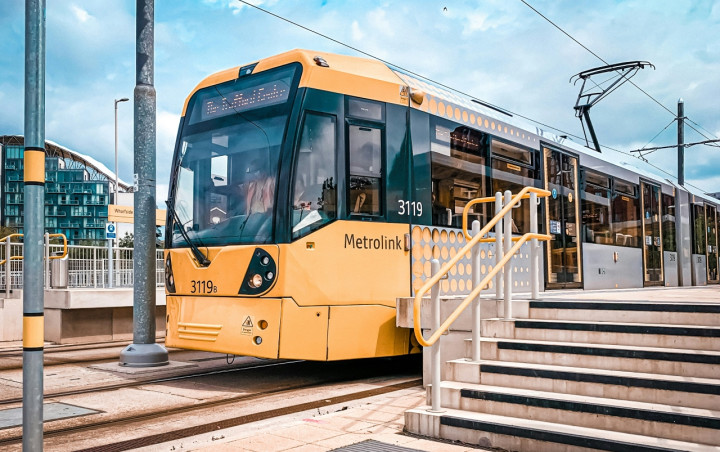Transport and infrastructure
Making public transportation the preferred mode of transport.

While all sectors significantly reduced CO² emissions between 1990 and 2022, emissions related to transport have increased a staggering 123%. We need to change our approach and make public transport the preferred method of transport for individuals and employers. Due to the geography of Slovenia, with many small villages in hilly or mountainous terrain, it is difficult to provide attractive, frequent and fast public transport everywhere. Private transport, mostly by car, will therefore retain an important role in the overall mobility patterns.
However, more sustainable choices must be supported to relieve our road system and environment from the burden of individual and freight transport and we have to better take into account externalities that also include noise pollution, congestion and effects on health.
Volt Slovenija proposes:
Increased availability public transport
Create the railway and bus infrastructure and reliability to use them to move half of the 900.000 daily car commuters to public transport.
Ensure sufficient park and ride (P+R) capacities with electric charging infrastructure in proximity to highways/train lines for seamless connectivity to medium and long distance busses and trains.
Remove legal requirements for minimum parking spaces for new constructions.
Reliable harmonised transport schedule
Introduce clock-face public transport schedules across the country with at least one train (bus) at the same minute every (second) hour following Switzerland, the Netherlands, the Czech Republic, Hungary and Slovakia.
Offer at least 1 train per hour (always at the same minute) on all main lines. Regional routes may be reduced to 1 train every 2 hours during lunch, evenings, weekends and holidays.
Offer at least 1 fast train (intercity/pendolino) per hour between Ljubljana, Celje and Maribor, every 30 minutes at peak times and at least 1 train every 30 minutes on suburban lines around Ljubljana (Logatec, Kamnik, Litija; Grosuplje, Kranj).
Coordinate arrival and departure times with short transfer windows between trains, local and regional bus lines at main transfer points (Ljubljana, Zidani Most, Celje, Pragersko, Maribor, Jesenice, Pivka, Divača, Sežana, Trebnje, Sevnica).
Introduce coordinated motorway intercity bus lines on connections the rail network cannot offer competitive travel times (Postojna - Ajdovščina - Nova Gorica - Gorizia, Maribor - Murska Sobota) and add the connections to the international train timetable database, so they can be found and booked by applications alongside trains.
High Speed rail network and capacity
Invest into rail infrastructure to reduce journey times and offer a seamless integrated timetable so Ljubljana-Celje, Celje-Maribor, Ljubljana-Jesenice and Ljubljana-Postojna can be done in less than 45 minutes.
Create double-track capacities where needed (single track may be sufficient) for allowing 1 train per 15 minutes in peak hours on Ljubljana-Kamnik, Ljubljana-Grosuplje and Ljubljana-Kranj lines also serving the airport.
Improved crossborder connectivity
Improve cross-border travel by offering at least 1 train every 2 hours for the following connections:
Ljubljana - Kranj - Jesenice - Villach (Beljak) (onwards to Salzburg and Munich)
Ljubljana - Zidani Most - Krško - Zagreb (onwards to Slavonski Brod, Beograd)
Ljubljana - Celje - Maribor - Leibnitz - Graz (Gradec) (onwards to Vienna (Dunaj))
Ljubljana - Postojna - Villa Opicina (Opčine) - Trieste (Trst) Airport (onwards to Udine (Videm), Venice (Benetke))
Improve regional cross-border travel by offering at least 1 train every 2 hours for the following connections:
Maribor – Dravograd – Bleiburg (Pliberk)
Sežana – Villa Opicina – Trieste Centrale (Trst)
Postojna – Ilirska Bistrica – Rijeka
Metlika – Karlovac
Rogaška Slatina – Krapina
Ormož – Čakovec – Mursko Središće – Lendava
Hodoš – Zalaegerszeg
Jesenice – Villach (Beljak) (1 train per hour)
Maribor – Spielfeld-Strass (1 train per hour)
Nova Gorica – Gorizia Centrale (Gorica) (1 direct bus transfer per hour)
Dobova – Zaprešić – Zagreb (1 train per hour, per 30 minutes during peak hours)
Airport connectivity
Ensure that Jože Pučnik airport is served by high-speed railway to make it easily accessible from all regions. A business-friendly environment that extends beyond Ljubljana must also include accessibility and connectivity for air travel.
Developing Slovenia’s air connectivity further by finding a concessionaire for Maribor’s airport and developing it as a LCC hub.
Analyze the potential to open a Slovenian flag carrier with a private-public partnership to improve Slovenian’s air connectivity further.
Reduced transit truck traffic and pollution
Set up ‘rolling highway’ train routes to transport road trucks by rail in cooperation with neighbouring member states to offer attractive longer routes such as Salzburg-Zagreb, Venice-Zagreb, Fernetiči-Budapest or Koper-Vienna.
Once set up, make usage mandatory for trucks that do not have a final destination in Slovenia to decrease transit truck traffic on roads.
Improved bike network
Support building a more sophisticated bike infrastructure starting with all large cities building on the expertise of countries like the Netherlands.
Introduce stricter laws requiring better bike infrastructure to be updated every time a road gets improved to follow the latest bike standards,
Connect the three Eurovelo tracks to the main Slovenian tourist destination to allow visiting them by bike. We’re still a 3rd world country with regards to bicycle infrastructure and should make an effort to increase the potential of more sustainable tourism.
(v4 11-2025)